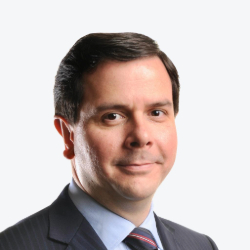Sep 04, 2025
Eurex | Eurex Clearing
FX market targets listed efficiencies with options push
FX options trading on Eurex has been gaining traction, supported by strong growth in FX futures liquidity and a broader industry shift towards listed derivatives. In this article, Imanol Urquizu, Head of Derivatives at Santander Asset Management, shares his perspective as an early advocate for an exchange-listed FX liquidity in Europe. Ramon Puyane, Head of FX Trading at IMC, discusses his firm’s expansion into FX and role as liquidity provider. Meanwhile, Tobias Rank, Global Product Lead for FX Derivatives at Eurex, provides insight into Eurex’s strategic direction.
Imanol, why is your firm such a strong advocate of more listed alternatives to OTC derivatives?
Imanol, Santander Asset Management: At Santander Asset Management, with over USD 250 billion AUM globally, we are strong advocates for the development of a comprehensive, exchange-listed FX derivatives ecosystem in Europe. The continued expansion of Eurex’s listed FX segment represents a meaningful step toward a more transparent and scalable market structure.

Migrating FX options from OTC to listed markets significantly reduces operational complexity and risk. Exchange-traded contracts remove bilateral counterparty exposure, reduce execution slippage, and streamline collateral and margining workflows. In contrast, OTC workflows often require complex legal arrangements such as ISDAs and Credit Support Annexes. There is also added friction around collateral management and counterparty approvals.
Those listed advantages are particularly pertinent for large asset managers such as Santander Asset Management. If you have 2,400 funds under management, having to sign ISDAs for each is a long and complicated process. There is also a strong case for smaller funds to use listed derivatives. These participants might have USD 20 million AUM and just want to trade some EUR/USD options. Doing so on exchange is much simpler and accessible for these firms too.
The listed model also enables centralized clearing, consistent margin methodologies, and a lower administrative burden. These are all critical components for institutional workflows.
The FX market is the most liquid asset class globally. By creating a listed framework for FX options, Eurex is unlocking access to this liquidity in a format that is operationally efficient and compatible with the needs of institutional asset managers.
As electronic infrastructure and pricing transparency improve, the transition of OTC liquidity into listed venues is becoming increasingly viable. For many market makers, quoting listed or OTC will become economically equivalent. Indeed, the listed form may eventually even be preferable, given the new considerations of EMIR 3.0 and similar regulations.
Once current structural hurdles such as screen pricing and achieving a critical mass of liquidity providers are fully addressed, the listed FX options market could scale rapidly. In EUR/USD options alone, open interest has the potential to grow beyond USD 100 billion in the short term. Santander Asset Management is ready to play its part in the liquidity complex from day one. We welcome Eurex’s leadership on the matter and support the evolution toward a truly pan-European listed FX infrastructure.
Ramon, how have you seen liquidity in listed and OTC FX options develop in recent years and why has IMC decided to enter the space?
Ramon, IMC: Ever since the global financial crisis (GFC), there has been a lot of client flow in OTC FX options, especially after 2019 when dollar rates started to rise. The product has very much been in vogue since then, as more traders took an interest in macro themes.

However, client flow is not necessarily the same as liquidity. The challenge since 2008 has been that various banks have taken a step back from providing liquidity in OTC markets. They are not as willing to warehouse risk and there are less of them participating in the market than before the GFC.
Exchanges play a vital role in enhancing the liquidity picture in FX options markets. Their all-to-all trading model transforms diverse market flows into a centralized liquidity pool, accessible to all participants through the transparent orderbook. This openness fosters tighter spreads and more efficient price discovery, enabling clients to benefit from improved pricing and faster execution compared to traditional OTC markets.
As a result, more participants are transitioning towards exchanges, and we expect substantial growth in listed FX option volumes.
IMC is a leading market maker with a proven track record in equity options products across exchanges. Our risk management and execution protocols enable us to provide superior liquidity both in the exchange orderbook and on a bilateral basis. Following our successful entry into the interbank broker market, we are now extending our capabilities to the listed FX options segment on Eurex with the same precision, reliability, and market impact that define our approach.
IMC is excited to be among the first liquidity providers to stream FX options prices into the Eurex orderbook. And our expertise in options also makes us a strong counterparty for block trades. This dual approach supports the growth of the listed FX options segment and helps buy-side firms harness the benefits of exchange-based trading.
Tobias, how can we expect the structure of this market to develop?
Tobias, Eurex: The establishment of our FX options segment has been a truly buy-side led development, with firms such as Santander Asset Management actively working with liquidity providers to create a holistic ecosystem on Eurex.

OTC FX options are covered by uncleared margin rules, and therefore subject to collateralization. Participants that move into listed FX options often experience a collateral and funding benefit through the exchange. This is mainly due to the multilateral netting that exchanges and their CCPs offer for any exchange traded product, including FX options. Central clearing also typically offers a lower margin period of risk, which in the case of FX options is two days compared to five days in the uncleared market.
At Eurex, we have seen our FX futures segment growing healthily since launch. More participants now want to do their FX options business with us too. This provides them with the benefit of risk offsets between FX futures and FX options. Combining this risk on Eurex can therefore be highly efficient from a funding perspective.
Block trades are where we expect the market to start. Liquidity will initially be based on bilateral trading models, with traders’ risk then being booked on exchange. This will be complemented by on-screen liquidity, where IMC has taken on a pivotal role in building this segment.
As the market progresses over time, we expect that the share of on-screen trading overall, including in FX options, will increase as more participants enter the market. That will include firms that are used to bilateral trading in the OTC Markets, as well as others such as hedge funds and CTAs, which prefer a more undisclosed, anonymous trading model, such as an order book. This is a development that we have seen in FX futures, and we expect to see the same in FX options too.
We see greater automation and electronification efforts across the buy-side and sell-side. We also increasingly see hybrid trading models that connect OTC and listed FX markets. These developments are resulting in largely automated solutions to price client requests and improved execution quality for listed FX derivatives.
